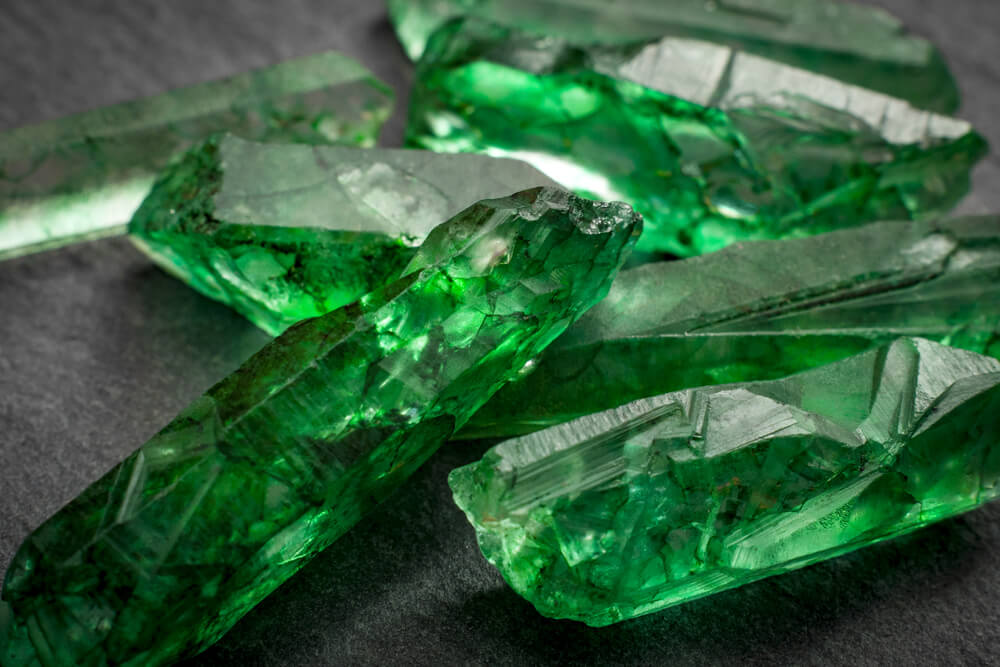In today’s article we will analyse some basic elements and properties of emerald, from the depths of history to the present day. Emerald is the green variety of the mineral species Beryl, which also includes aquamarine, morganite and other varieties in various colors.
The properties of emerald
Very little was known about the chemical and physical properties of emerald until around the end of the 18th century, when Nicolas Louis Vauquelin published the first chemical analysis of the stone. This allowed emerald to be classified as a beryl. The formation of emerald requires a combination of highly unusual geological conditions and the presence of rare chemical elements found at various depths and in different rocks of the earth.
Most emeralds on the market have a range of purity characteristics. Almost all emeralds contain few to many inclusions that are often visible to the naked eye. This typical emerald appearance is referred to as “jardin” in the market, (French for garden). Colombia, Zambia, Brazil and Zimbabwe supply the majority of our emeralds on the international market. Additional sources are Pakistan, Afghanistan, Madagascar and Ethiopia, among others. In all these countries, political/social problems combined with physical barriers (remote locations, prohibitive weather conditions, etc.) make it very difficult to get emeralds into the market.
Some historical data on emeralds
The famous Egyptian emerald mines, also known as the Cleopatra mines, were the world’s first source of emeralds until the discovery of important sources in South America in the 16th century. Experts estimate that the Sikait and Zabara mines were in operation by 3500 BC, while other estimates place their start of operations in the 20th century BC.
But how is Cleopatra connected with emeralds? The emerald is, in fact, synonymous with Cleopatra. The legendary queen understood long before anyone else that in order to inspire fear and respect, she had to look impressive, almost godlike in her leadership. And she accomplished this by owning all the gems and showing them off at every opportunity.
For the ancient Egyptians, the colour green was associated with fertility, the rebirth of the earth during the annual overflow of the waters of the Nile River, and the Pharaohs were buried with emeralds as a symbol of eternal life.
Ancient manuscripts demonstrate that the Indians worshipped emeralds almost as much as the Egyptians. The Indian aristocracy kept the best and exchanged the rest for various gems from all parts of the world. Quality was of prime importance. They believed that only the finest gems and the purest gold would create the most suitable conditions and maximum power to honor the gods and serve as talismans to keep evil at bay.
The ancient Greeks and Romans
On the other hand, the ancient Greeks were known to be equally fond of gemstones. The famous ring of Polycrates is believed to have featured an emerald. Also, the Greek historian Herodotus mentions an emerald stele in the temple of Hercules in Tyre, and Plato includes emerald among other known gemstones of the period. According to Albertus Magnus, a famous medieval priest and scholar, Alexander the Great had incorporated a magical emerald into his belt.
The Romans were also known for their love of precious stones, especially emeralds and pearls. While gold was mined in various Roman provinces, emeralds, amethysts and pearls were imported from the East. In addition to their beauty and value, emeralds were also used for their healing properties. According to Pliny the Elder, Roman goldsmiths often soothed their tired eyes by looking through emeralds while they worked.
Emeralds were also highly valued by the Aztec, Olmec, Mayan and Incan cultures of Middle and South America. They were mined since the depths of time in areas of what is now Colombia.
Finally, in the mid-15th century, with the discovery of the New World by Columbus, a large number of Europeans travelled to South America and were enchanted by the green ornament worn by the natives. It was not long before they plundered the regions and sent the precious emeralds to Europe, where they immediately became a status symbol in the high society of Europe.
Eva Kountouraki GG, AJP, JBM
Gemology Instructor, Jewellery Consultant


